Artwork takes visitors on medical
history walk in ART
by Dick Peterson Special to The Catalyst
The combined talents and resources of a few MUSC employees has turned blank walls in the Ashley River Tower (ART) into a 300-year walk through medical history in Charleston.
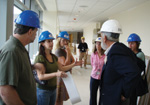 Hal Currey, Marc
Sloan and the rest of the installation team from the Halsey Gallery
discuss the timeframe for installation of these and other art
installtions in ART.
Hal Currey, Marc
Sloan and the rest of the installation team from the Halsey Gallery
discuss the timeframe for installation of these and other art
installtions in ART.The task could have seemed like an impossible mission, one better suited for a professional design firm equipped and experienced for producing large public displays. But one look at the cost of outsourcing the project was all it took to put Susan Hoffius, Lisa Fennessy, Lawrence Owens, Thomas Hamm II and Sherman Paggi to work.
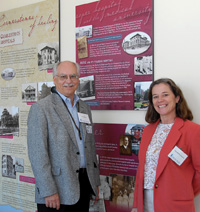 Larry Owens and
Lisa Fennessy in front of the “Hospital History” segment of the fourth
floor exhibit during ART dedication ceremonies Oct. 12.
Larry Owens and
Lisa Fennessy in front of the “Hospital History” segment of the fourth
floor exhibit during ART dedication ceremonies Oct. 12.“The idea was to create a cultural exhibit in Ashley River Tower that reflects Charleston, its environment, its cultural attitudes and social structure so people will know they are in the heart of the South Carolina Lowcountry,” Hoffius said.
Hoffius is curator of the Waring Library, which she calls “the university’s institutional memory.”
 The
team was given one of three hallways, each of which connects a
floor of the ART bed tower to the hospital’s diagnostic/treatment
building. Their historical exhibit was given the fourth floor, the
third was given to the Gibbes Art Museum and the second to the South
Carolina Aquarium.
The
team was given one of three hallways, each of which connects a
floor of the ART bed tower to the hospital’s diagnostic/treatment
building. Their historical exhibit was given the fourth floor, the
third was given to the Gibbes Art Museum and the second to the South
Carolina Aquarium. Hoffius, who managed the project, said she contacted Fennessy, a graphic artist in the Department of Art Services, to see if the project was something within her ability to handle. She and Fennessy had worked together on much smaller exhibits for the library. After reviewing the proposal Hoffius sent her, Fennessy talked to Hamm and Owens and together they decided they could manage the design work and fabrication of the panels for the historical exhibit.
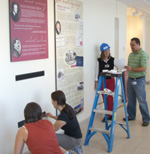 Susan Hoffius
and Hamm supervise the installation of the panels prior to the
dedication ceremony.
Susan Hoffius
and Hamm supervise the installation of the panels prior to the
dedication ceremony.“When Susan approached me with this project, she told me that President Greenberg had a written proposal from another (off-campus) group,” Fennessy said. “The cost was high, so Susan suggested using us. I researched the itemized costs for the same material and came up with a bid of about $19,000 less for just the one floor.”
Ultimately, Fennessy was tasked with the production of displays on all three floors. That includes printing the up to 36-by-84-inch panels on a special large-format printer and using a special ink that won’t fade in sunlight, mounting each on 3/4-inch Gatorfoam, and laminating the units with a transparent surface to protect against damage from ultraviolet light, water and fingerprints. “These are permanent displays and we expect them to last the lifetime of the building,” she said.
“So suddenly we went from considering outsourcing the work to deciding we could do it with in-house talent,” Hoffius said. With selected exhibits from the Gibbes and the aquarium, the five put together a work plan in which MUSC took responsibility and cost for all the fabrication work, leaving the aquarium to do their own design work and provide digital files to print.
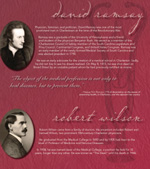 The
Gibbes produced artwork and text, and worked with Paggi in the MUSC
main library who designed the third floor display to be compatible with
Hamm’s design of the historical exhibit and incorporate the museum’s
aesthetics. Hamm said that as a graphic artist himself, he can
appreciate the difficulty of Paggi’s task and it was one he did well.
The
Gibbes produced artwork and text, and worked with Paggi in the MUSC
main library who designed the third floor display to be compatible with
Hamm’s design of the historical exhibit and incorporate the museum’s
aesthetics. Hamm said that as a graphic artist himself, he can
appreciate the difficulty of Paggi’s task and it was one he did well. “It’s been fun,” said Owens, who is director of communications with the MUSC Education and Student Services Administration. With a smile and in his calm, laid-back demeanor, he described how he was presented with a floor plan and elevation of the three hallway walls, just an eight-and-a-half-by-eleven sheet of paper copied from a blueprint. “At least the dimensions were accurate.”
He said the first step was to get a sense of scale for the project. An observer in the hallway would require text large enough to read while standing back far enough to view the entire display with its ample number of images all designed to be viewed as a unit.
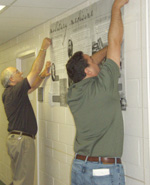 Owens, left, and
Hamm hang lifesize mock-ups of the panels in the hallway of the Harper
Student Center to help determine their size.
Owens, left, and
Hamm hang lifesize mock-ups of the panels in the hallway of the Harper
Student Center to help determine their size. Owens managed his team, made sure it stayed on schedule, and provided materials as needed.
“He even called in the university carpentry shop to trim the dense, fibrous foam core material for us. It was a real problem for us, but for them it was a piece of cake,” Fennessy said. “Larry kept us on schedule. He stayed on top of the project and got us anything we needed. And he was real good at figuring the measurements and spacing between panels.”
“Lisa came to me after meeting with Susan (Hoffius) at the Waring Library,” Hamm said as he booted his Mac computer to show the design work he had done. Hamm is a graphic artist and visual communications manager in Education and Student Support. “She was given the forefront on design concept and the panel materials for mounting the exhibits. She knew I had experience on the newer design software.”
Images on the oversized screen connected to Hamm’s computer came alive as he called up one of the nearly completed panel designs. He had coordinated his design work to be compatible with the design and color scheme of the hospital.
“From there the project took on a life of its own,” he said. Beginning with a tour of the actual space where the exhibit would be installed, “We asked ourselves, `What do we really want? How big do we want it?’ Some of these questions can only be answered by standing there looking at it.” Hamm said that one concern was that a design on his computer screen could yield text print too large for a hallway viewer to read when sized to fit a panel. As the designs progressed, life-sized black and white panels were assembled and mounted on the walls, replacing the space holders. Half-sized test prints in color were produced for several of the panels to make adjustments in color, shading and to rule out potential printing problems.
“At our next meeting we planned the placement and size of the panels and asked, `What do we have that we can put in the exhibit?’ Susan had already collected the images and written a draft of the text, but just getting all that into my computer required more server space,” Hamm said.
It’s from that huge collection of images that he has designed the exhibit panels displaying histories of McClennan-Banks Hospital, which originally occupied the site where ART now stands, student life, military medicine, medical education and Charleston hospitals.
“I began by reading through the text and letting a phrase or word spark an idea, and then I built on it from the images I had from the Waring Library,” Hamm said. All the images for the panels came from the Waring Library with the exception of one from the University of South Carolina.
Fennessy said the project demonstrates what the Art Services Department can do and what can be accomplished when collaborating with other departments. She said that some in the university are unaware of the resources they have in-house and often out-source their art work at a greater cost.
The exhibit, “300 Years in the Making: History of Healthcare in Charleston,” is complete and was on temporary display Oct. 12 during the formal dedication of ART.
Permanent installation of the panels will have to wait for construction in the building to be completed and in time for patient admittance.
Friday, Nov. 30, 2007
Catalyst Online is published weekly,
updated
as needed and improved from time to time by the MUSC Office of Public
Relations
for the faculty, employees and students of the Medical University of
South
Carolina. Catalyst Online editor, Kim Draughn, can be reached at
792-4107
or by email, catalyst@musc.edu. Editorial copy can be submitted to
Catalyst
Online and to The Catalyst in print by fax, 792-6723, or by email to
catalyst@musc.edu. To place an ad in The Catalyst hardcopy, call Island
Publications at 849-1778, ext. 201.